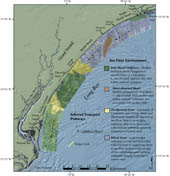|
|
Discussion
Sediment Transport
 |
Figure 19. Map showing the four primary sea floor environments within Long Bay
Click on figure for larger image and full caption.
|
Qualitative assessments of sediment transport directions can be inferred from the general morphology and textural variations within the inner shelf. Perspective views of the regional morphology and backscatter and textural variations characteristic of the study area are displayed within figures 11, 17 and 18. Within all ridgelike features, high-backscatter, poorly sorted, coarse-grained trough and NE sides lie adjacent to low-backscatter, moderately-sorted, medium- to fine-grained crest and SW sides. These textural and morphologic signatures may reflect the long-term erosion of the inner shelf. Similar processes were described by Schwab and others (2000) and Twichell and others (2003), where reworking of inner-shelf deposits results in selective transport of finer grained sediments, leaving a coarse-grained winnowed lag. Based on geomorphic and textural evidence within Long Bay, net long-term transport of fine-grained sediments appears to be to the southwest, producing a winnowed lag on the northeast side of low-relief ridges (fig. 19). However, local perturbations to long-term net southerly flow may exist. Cross-cutting bedforms directly landward of the shore-detached shoal offshore of northern Myrtle Beach (fig. 8) suggest that there may be some cross-shelf component to flow. Recent work by Gutierrez and others (2006) show that in the study area cross-shelf flow may persist under certain prevailing wind conditions.
|